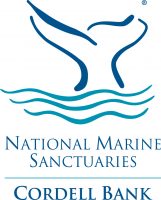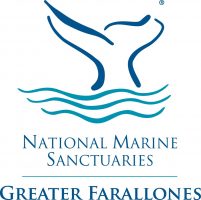ACCESS research takes place in north-central California, which is one of the most productive marine environments in the world. The high productivity here is the result of coastal upwelling, an oceanic response to winds along the coastline, which brings cold, nutrient-rich water to the surface. This enhances primary production, supports an abundant zooplankton prey base, and attracts seabirds, marine mammals, and other wildlife.
Surveys focus on the oceanic habitats in Federal and State waters within Cordell Bank, Greater Farallones and Monterey Bay National Marine Sanctuaries. National Marine Sanctuaries are considered NOAA sentinel sites; these are ideal places to conduct recurring studies which help us detect and track ecosystem changes associated with large scale oceanographic events like El Niño and the changing ocean climate.
Cordell Bank National Marine Sanctuary
Established in 1989 to protect and preserve the extraordinary marine ecosystem surrounding the Cordell Bank with a total area of 1,286 square miles. Surrounded by soft sediments of the continental shelf seafloor, Cordell Bank emerges with a rocky habitat, providing home to colorful and abundant invertebrates, algae, and fishes. [Read more]
Greater Farallones National Marine Sanctuary
Established in 1981 to protect the wildlife, habitats, and cultural resources of one of the most diverse and bountiful marine environments in the world, an area of 3,295 square miles off the northern and central California coast. The waters within Greater Farallones National Marine Sanctuary are a nationally significant marine ecosystem, and support an abundance of life, including many threatened and endangered species. [Read more]
Monterey Bay National Marine Sanctuary
Established in 1992 to protect extensive kelp forests and one of North America’s largest underwater canyons and closest-to-shore deep ocean environments. The sanctuary protects 6,094 square miles diverse marine ecosystems that also includes rugged rocky shores, wave-swept sandy beaches and tranquil estuaries. These habitats harbor an incredible variety of marine life, including 36 species of marine mammals, more than 180 species of seabirds and shorebirds. [Read more]



